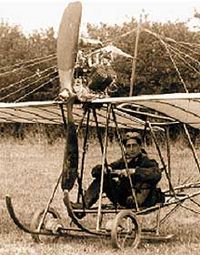Edwin Moon
| Edwin Moon | |
|---|---|

Edwin Moon in Moonbeam II, the first plane to take off from Southampton Airport
|
|
| Born |
8 June 1886 Southampton, England |
| Died | 29 April 1920 (aged 33) Felixstowe, England |
| Resting place | Southampton Old Cemetery |
| Nationality | English |
| Occupation | Pioneer aviator and RNAS pilot |
| Spouse(s) | Isabel Madeline Waldron (from 1911–1920) |
| Children | Daughter Mary (b. 1915) |
| Parent(s) | Edwin George Wade Moon Catherine Esther Butt |
| Awards |
DSO and bar The Legion of Honour - Croix de Chevalier Royal Humane Society silver medal |
Squadron Leader Edwin Rowland Moon DSO* (8 June 1886 – 29 April 1920) was an English aviation pioneer who served in the Royal Naval Air Service and Royal Air Force during the First World War. He was a prisoner of war and he was twice awarded a DSO.
Moon was one of four children of Edwin George Wade Moon and Catherine Esther Butt, who lived in Cranbury Avenue in Southampton. Moon married Isabel Madeline Waldron in 1911 and had a daughter named Mary in 1913.
The Moon family owned a boat-building business based at the Wool House. The Moonbeam Engineering Company Limited built motor launches and later expanded to include the sale of wrought iron propellers and marine engines for export around the world. Edwin Moon, possibly inspired by the 1903 Wright brothers flight, took a corner of the workshop to realise his dream of constructing and flying an aircraft of his own design.
He tested his first plane, Moonbeam I, in the Fawley area, near the home of his future bride. His first short "hop" took place on Websters Field at Ower Farm, near Calshot and at Moulands Field, Regents Park. Following these test flights on the prototype plane, he built a second plane, Moonbeam II.
Moonbeam II was a monoplane, weighing 260 lbs, of which 160 lbs was engine and propeller. A V-4 cylinder, 20 h.p. J.A.P engine was fitted, and it had a 6 ft wooden propeller. In 1910, the plane was conveyed by horse-drawn cart to the meadows belonging to North Stoneham farm from where he made the first successful flight; the precise date of the first flight is not known, although researchers believe that it was between 12 April 1910 and 11 June 1910.
The following year, on 2 April 1911, a French pilot, Maurice Tétard, flying from Brooklands to Larkhill, called at North Stoneham to make some adjustments; although he only stayed for about half an hour, a large inquisitive crowd rapidly gathered to admire the plane. In 1917, the field at North Stoneham was requisitioned by the War Office as an Aircraft Acceptance Park, but before completion, the base was given to the US Navy to develop an assembly area; this subsequently evolved into Southampton International Airport.
...
Wikipedia
